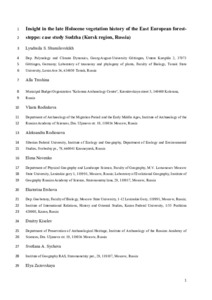Показать сокращенную информацию
Insights Into the Late Holocene Vegetation History of the East European Forest-steppe: Case Study Sudzha (Kursk region, Russia)
| Автор | Шумиловских, Л. С. | |
| Автор | Родинкова, В. Е. | |
| Автор | Родионова, А. Б. | |
| Автор | Трошина, А. А. | |
| Автор | Ершова, Е. Г. | |
| Автор | Новенко, Е. Ю. | |
| Автор | Зазовская, Э. | |
| Автор | Сычева, С. А. | |
| Автор | Киселев, Д. И. | |
| Автор | Schlütz, F. | |
| Автор | Schneeweiß, J. | |
| Дата внесения | 2020-01-20T08:03:50Z | |
| Дата, когда ресурс стал доступен | 2020-01-20T08:03:50Z | |
| Дата публикации | 2019-09 | |
| Библиографическое описание | Шумиловских, Л. С. Insights Into the Late Holocene Vegetation History of the East European Forest-steppe: Case Study Sudzha (Kursk region, Russia) [Текст] / Л. С. Шумиловских, В. Е. Родинкова, А. Б. Родионова, А. А. Трошина, Е. Г. Ершова, Е. Ю. Новенко, Э. Зазовская, С. А. Сычева, Д. И. Киселев, F. Schlütz, J. Schneeweiß // Vegetation History and Archaeobotany. — 2019. — Т. 28 (№ 5). — С. 513-528 | |
| ISSN | 09396314 | |
| URI (для ссылок/цитирований) | https://link.springer.com/article/10.1007/s00334-018-00711-4 | |
| URI (для ссылок/цитирований) | https://elib.sfu-kras.ru/handle/2311/129771 | |
| Аннотация | Today, the East European forest-steppe is an agricultural landscape with very few remains of its former natural vegetation. The history of the transformation from natural vegetation to a human-made landscape in the area of Sudzha (Kursk region, Russia) is studied here. We compare the off-site pollen record Sudzha with three on-site pollen records obtained from the archaeological site Kurilovka-2. The sediment core Sudzha covering the last 2,500 years was taken from an oxbow lake in an area with archaeological sites of the early Slavonic period (3rd–8th centuries ce). The Sudzha pollen record indicates dominance of broadleaf forests and meadow steppes in the area from 2,500 to 200 cal year bp with two major settlement phases one between ~ 2,000 and 1,600 cal year bp (~ 50 bce to 350 ce) and the other between 1,100 and 600 cal year bp (850 and 1350 ce) followed by a total deforestation and transformation to an agricultural landscape over the last 200–300 years. Similar changes in the last 300–400 years are indicated by the three on-site pollen records. It is noteworthy, however, that the record Sudzha does not provide an intensive signal of human impact during the 5th–8th centuries ce. This points to a quite restricted spatial influence of the Early Slavonic settlements on the vegetation, leading to a relatively low contribution of palynological anthropogenic indicators to the regional pollen rain signal. | |
| Название | Insights Into the Late Holocene Vegetation History of the East European Forest-steppe: Case Study Sudzha (Kursk region, Russia) | |
| Тип | Journal Article | |
| Тип | Journal Article Preprint | |
| Страницы | 513-528 | |
| ГРНТИ | 39.19.29 | |
| Дата обновления | 2020-01-20T08:03:50Z | |
| DOI | 10.1007/s00334-018-00711-4 | |
| Институт | Институт экологии и географии | |
| Подразделение | Кафедра экологии и природопользования | |
| Журнал | Vegetation History and Archaeobotany | |
| Квартиль журнала в Scopus | Q1 | |
| Квартиль журнала в Web of Science | Q1 |

